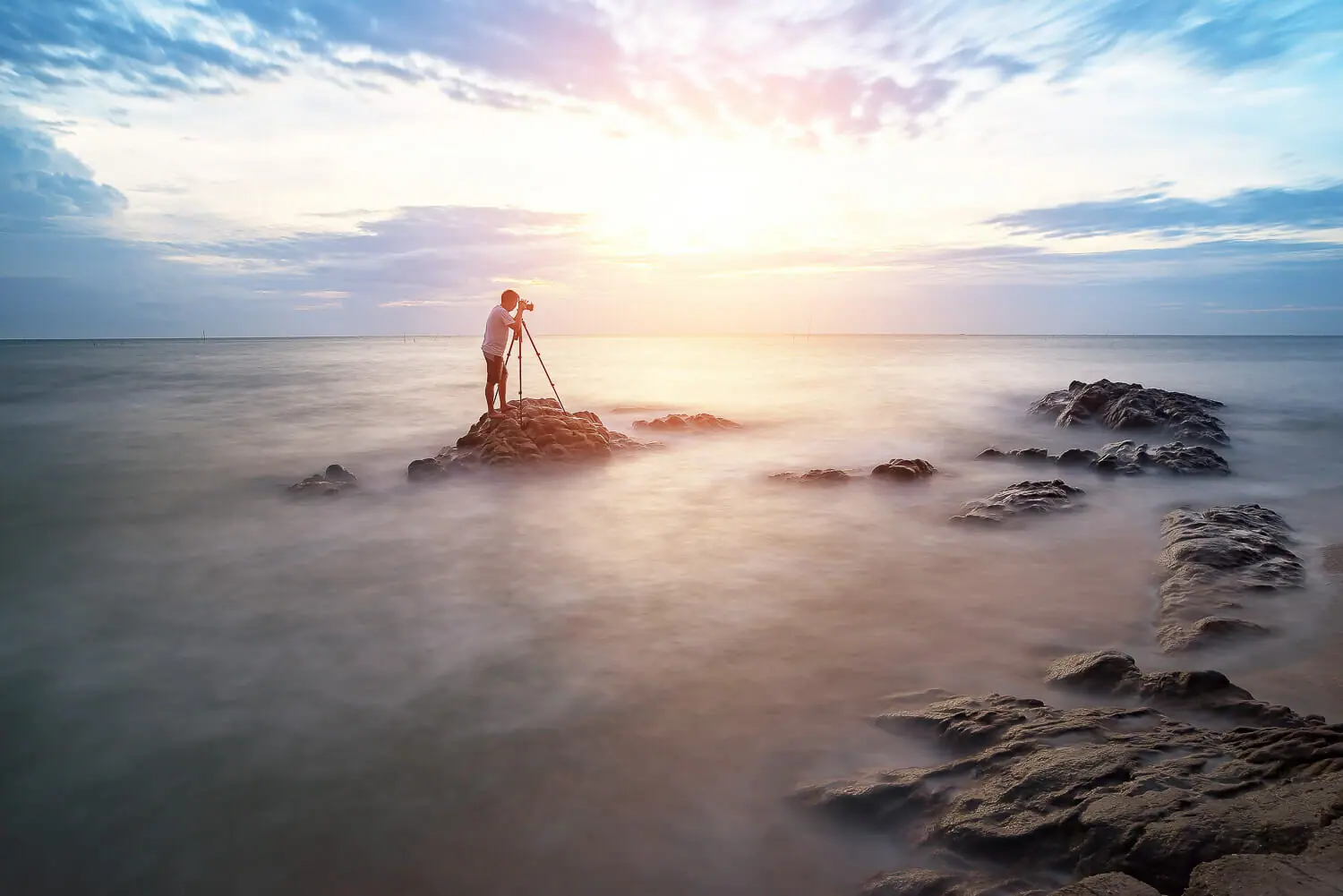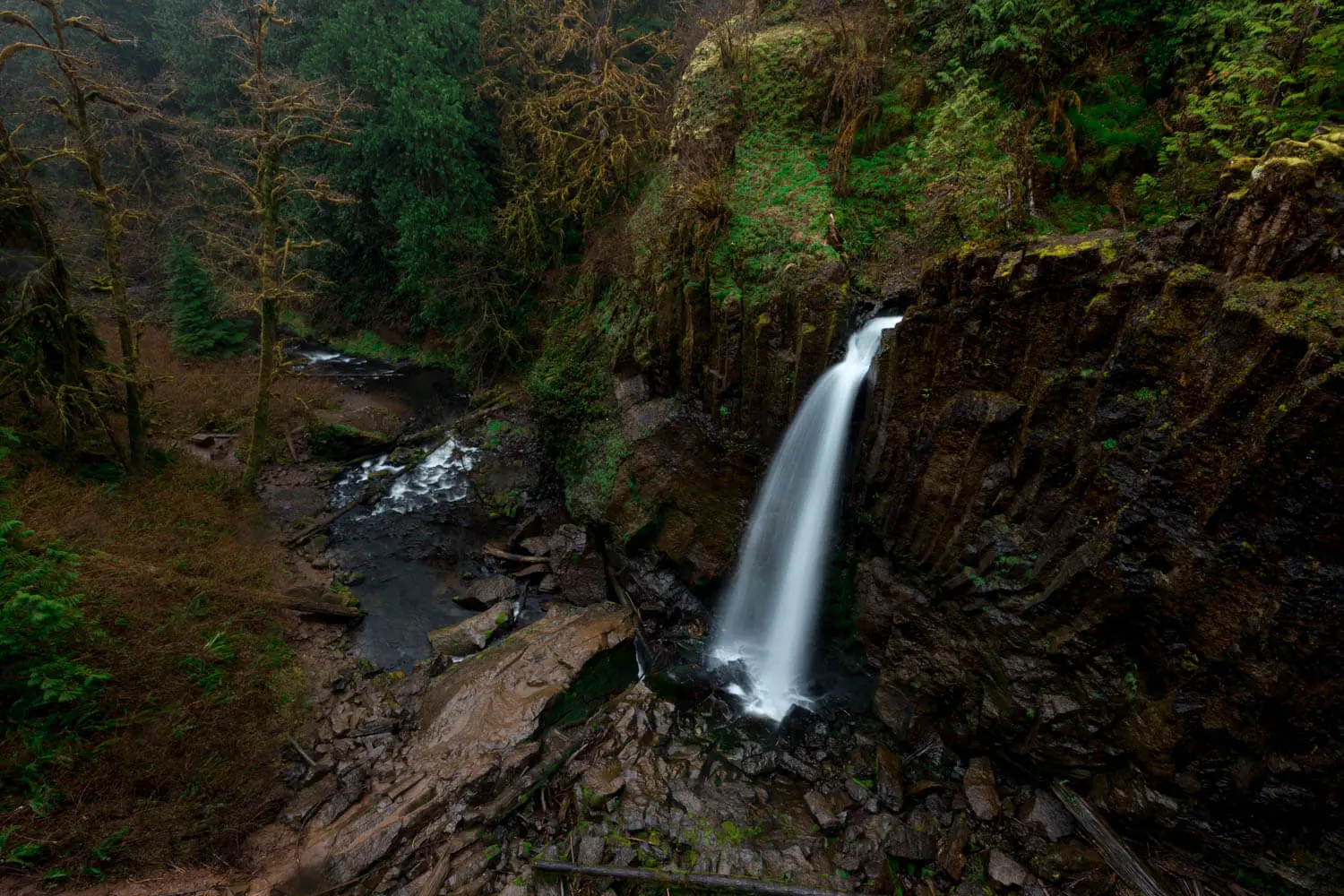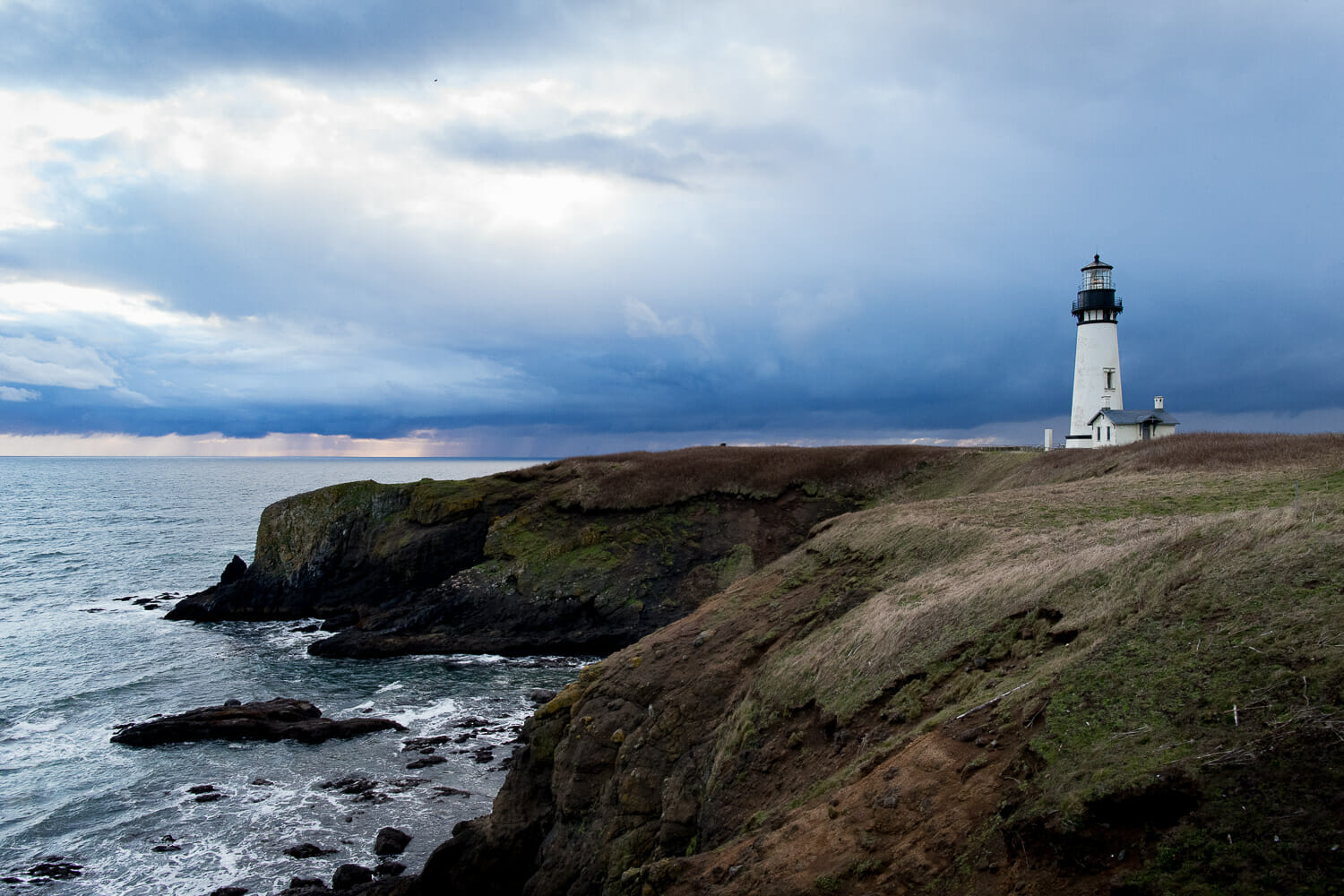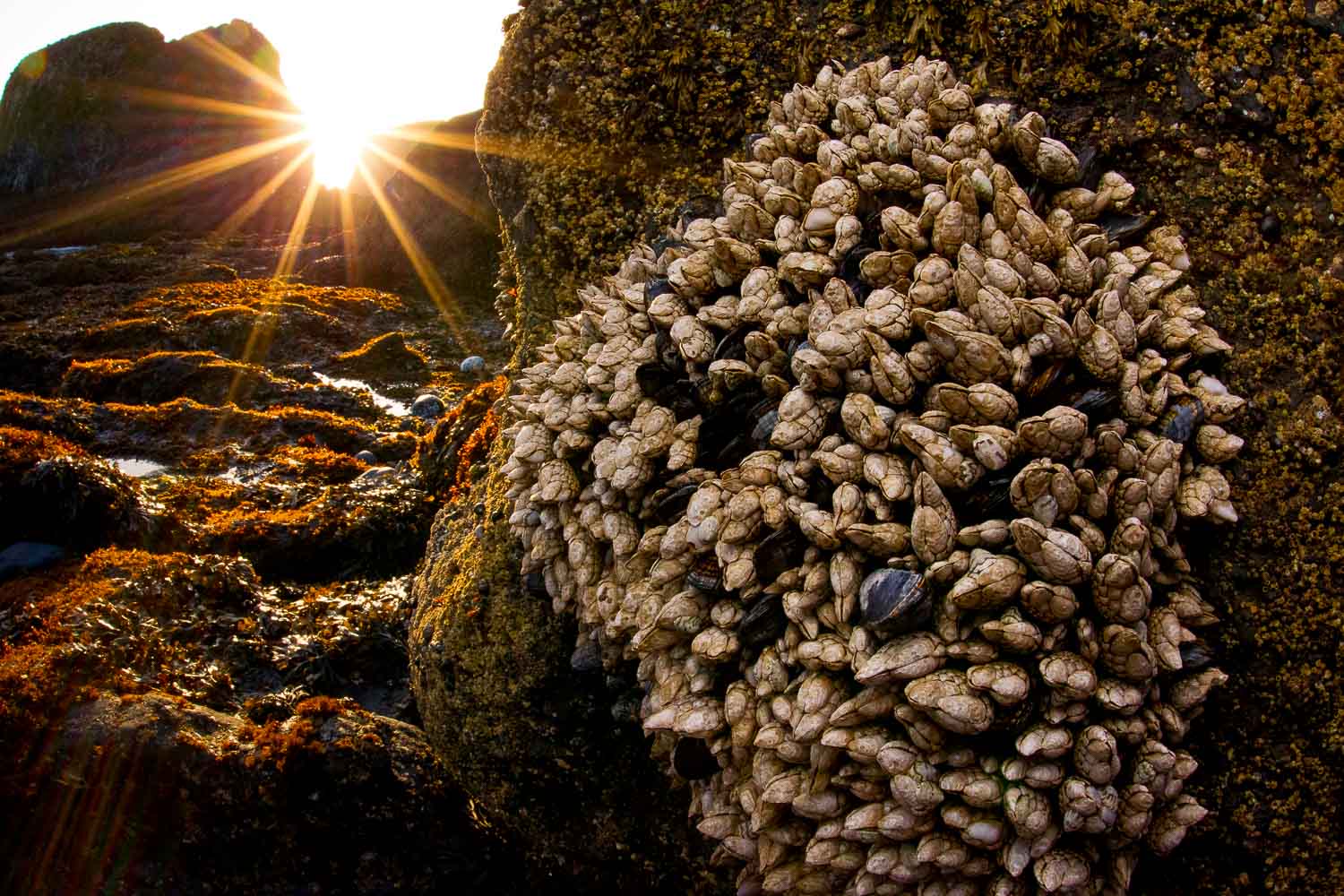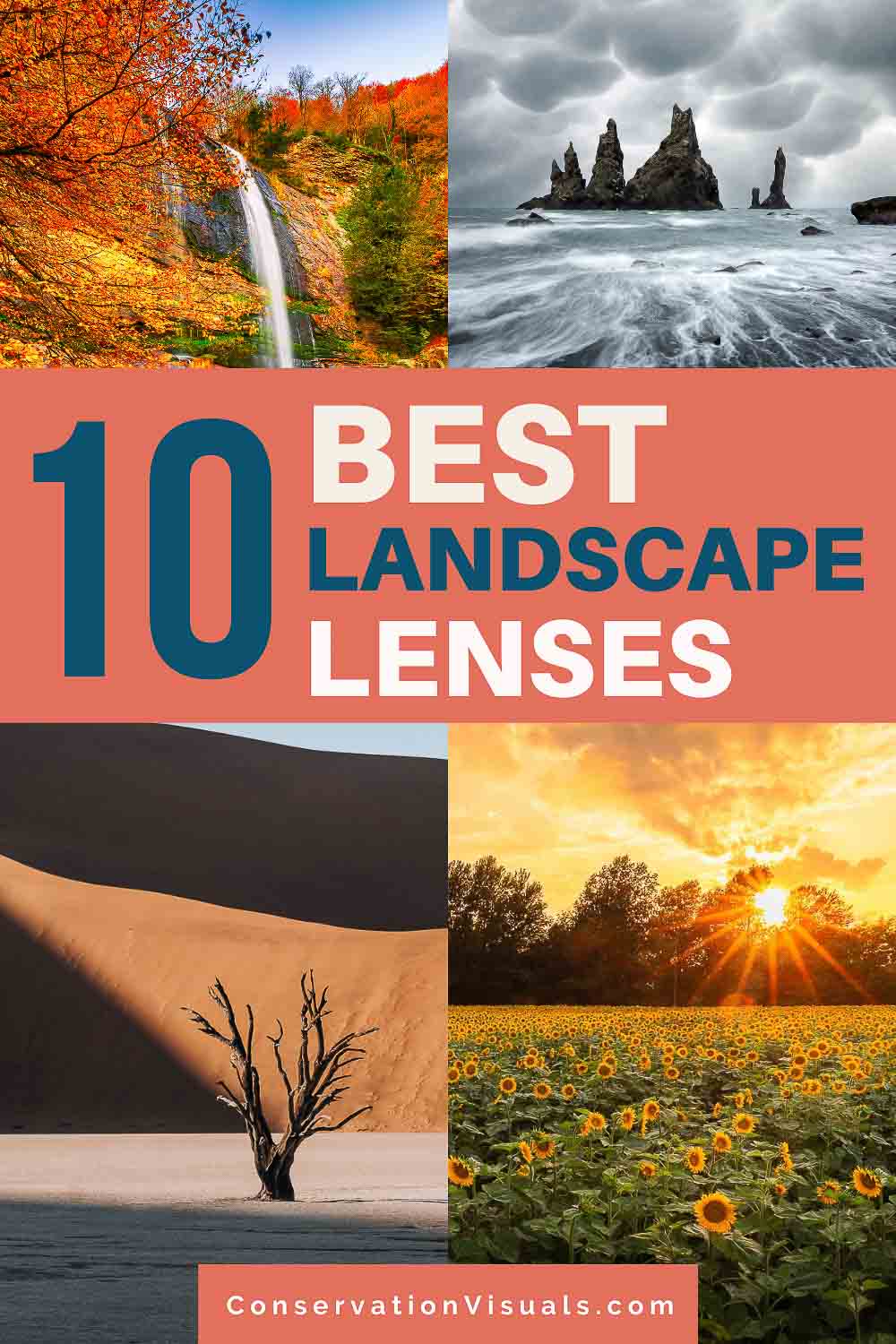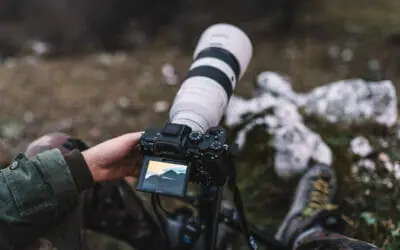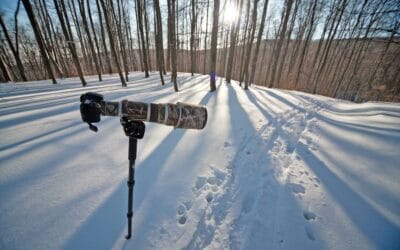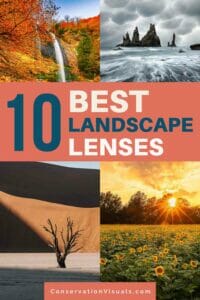Contents
- Types of lenses
- What's the best lens?
- FAQs
- How to pick a lens
- Factors to consider
- Best Lenses for Landscape Photography
- Canon EF 16-35mm
- Canon RF 14-35mm
- Canon RF 15-35mm
- Nikon AF-S NIKKOR 16-35mm
- Nikon NIKKOR Z 14-30mm
- Fujifilm XF 10-24mm
- Panasonic Leica DG Vario-Elmarit 8-18mm
- Sony FE 16-35mm
- Sigma 16-28mm
- Olympus M. Zuiko 40-150mm
Capturing the vast beauty of landscapes requires not just an aesthetic eye, but also the right tools.
The lens you select can make a world of difference in bringing out the depth, details, and vibrancy of a scene.
Choosing the perfect landscape lens may seem daunting given the myriad of choices available. But don't worry – we're here to break it down and make it simple for you.
Our guide helps you navigate the world of landscape lenses, shedding light on their characteristics, the difference they make, and tips on selecting the best lens for your next outdoor adventure.
Contents
- Types of lenses used for landscape photography
- What's the best lens to use for landscape photography?
- FAQs
- How to choose a landscape lens
- Factors to consider
- Canon EF 16-35mm
- Canon RF 14-35mm
- Canon RF 15-35mm
- Nikon AF-S NIKKOR 16-35mm
- Nikon NIKKOR Z 14-30mm
- Fujifilm XF 10-24mm
- Panasonic Leica DG Vario-Elmarit 8-18mm
- Sony FE 16-35mm
- Sigma 16-28mm
- Olympus M. Zuiko 40-150mm
- How to choose the best landscape photography lens for YOU
Photo: Jaymi Heimbuch
Types of lenses used for landscape photography
A common question is: Are standard lenses, telephoto lenses, or prime lenses used in landscape photography?
Honestly, any lens can be a landscape lens. It depends on your creative vision and what you want to achieve.
That said, each lens type lends itself to a different style and approach to landscape photography, expanding the creative possibilities.
Wide-Angle Lenses
For those expansive landscapes where you want to capture as much as possible, wide-angle lenses are the go-to choice.
They offer a broader field of view, allowing you to cram more of that beautiful scenery into your frame.
The result? Spectacular panoramic or sweeping views of landscapes that really convey a sense of grandeur and space.
Telephoto Lenses
At the other end of the spectrum, we have telephoto lenses. These are perfect for isolating specific elements within a larger landscape.
Want to focus on a single mountain peak, a unique tree, or an interesting rock formation? A telephoto lens will let you do just that, making the subject stand out by creating a blur in the background.
Standard Lenses
Standard lenses – also called a normal lens – is a lens with an angle of view that closely mimics that of the human eye (not including peripheral vision) and hence produces images that appear “natural” to viewers.
So, standard lenses, often ranging from 35mm to 70mm, are excellent for capturing a perspective similar to how the human eye sees a scene.
Prime Lenses
Prime lenses, with their fixed focal length, are another excellent choice for landscape photography.
Known for their excellent image quality, sharpness, and brightness, these lenses can often outperform zoom lenses.
Prime lenses also tend to have faster maximum apertures, making them a fantastic option for low light landscapes, such as during twilight or nighttime.
Their simplicity encourages you to think more creatively about framing and composition, as you can't zoom in or out to adjust what's in your frame. Instead, you move closer or further from your subject, adding a dynamic element to your landscape photography process.
Photo: Jaymi Heimbuch
What's the best lens to use for landscape photography?
The answer to the “best” lens for landscape photography ultimately depends on your personal style, the specific scenario you're shooting in, and the narrative you wish to express through your images.
In general, though, most photographers gravitate towards wide-angle lenses for their ability to capture vast, sweeping vistas.
These lenses often become the top choice due to their capability to portray the grandeur of landscapes and the sense of being ‘in' the scene.
For those who love detailing and storytelling through specific elements in the scene, telephoto lenses provide an excellent option. They can isolate subjects, draw attention to details often overlooked, and create dramatic compositions even from seemingly ordinary landscapes.
And let's not forget the faithful standard lenses, which render the scene as close as possible to our normal field of view. They're versatile, allowing you to capture landscapes as we see them, making them a great all-rounder for various photography scenarios.
So, while there's no one-size-fits-all answer, each lens type has its strengths.
The real key to deciding the “best” lens is to understand what each lens can do and how it can enhance your particular style of landscape photography.
With that in mind, let's answer some common questions about landscape lenses.
FAQS
1. What's the difference between a wide-angle lens and an ultra wide-angle lens?
This allows for a much larger field of view, which can produce a dramatic perspective and a sense of depth in photographs.
However, ultra wide lenses can cause distortion at the edges of the frame, especially in photos with lines or horizons, plus they often have a protruding front element, which can prevent the attachment of filters.
Photo: Jaymi Heimbuch
2. Is 24mm wide enough for landscape?
While it might not give you the extreme coverage of an ultra-wide lens, a 24mm lens offers a balance between a wide perspective and minimal distortion, preserving the natural elements of the scene.
Plus, it's versatile enough to be used in a variety of other photography genres as well, making it a practical addition to any photographer's gear.
In fact, if you're looking for a highly versatile lens for both landscape and other types of photography, consider a 24-70mm zoom lens. This'll give you the flexibility needed for different types of landscape photos, as well as a practical lens to use in other niches.
Photo: Jaymi Heimbuch
3. Is 50mm good for landscape photography?
While it's not the typical choice for landscapes as it doesn't provide the wide field of view typically associated with this genre, a 50mm lens offers a perspective similar to the human eye, so. it produces images that feel natural and honest.
Because it is a fast lens with a wide aperture (often as low as f/1.2 in higher-end models), this lens excels in showcasing specific elements in the landscape. So, it allows you to capture intricate details and patterns without the distortion that wider lenses may introduce.
And, with that dreamy wide aperture, a 50mm lens can perform well in low-light conditions. This means more flexibility when shooting during the golden hour, in overcast weather, or doing night sky landscape photography.
It's always worth remembering that creativity and vision play a significant role in landscape photography, and sometimes, using a less conventional lens like a 50mm can result in unique and compelling images.
4. When should I use different lens focal lengths?
Use wide-angle lenses (24mm and below) when you want to capture vast landscapes, architecture, or interior spaces, as they offer a broader field of view.
Standard lenses (around 50mm) are great for a natural perspective and are versatile for various types of photography. (Again, these are also called normal lenses – the terms are interchangeable.)
Telephoto lenses (70mm and above) are ideal for isolating subjects or capturing details in landscape scenes or wildlife from a distance.
Ultimately, experimenting with different focal lengths will allow you to discover unique perspectives and elevate your photographic creativity.
How to choose a landscape lens
Typically, that's going to be a wide-angle zoom.
Wide-angle zoom lenses are most popular due to their wide field of view that enables photographers to capture large expanses of landscapes within a single frame and their greater depth of field that allows for both the foreground and background to be sharply focused.
Of course many landscape photographers swear by a standard zoom or others that prefer an ultra-wide lens and, depending on what you're shooting, you may want to throw a standard lens or even a telephoto lens into your kit.
Whatever lens allows you to shoot landscapes the way you want to is the best lens to use.
Once you decide on the type of lens that's going to get you the landscape photos you envison, consider your camera lens compatibility and go from there.
You'll want to consider factors like focusing distance (do you want to have the ability to capture creative foreground elements?), lens weight (how far out do you plan on trekking to capture your shots?), weather-sealing (who knows what type of weather you'll encounter out there!), image stabilization (maybe not that important if you exclusively plan to use a tripod, but what if you're shooting hand-held?) – the list could go on-and-on, but let's stick with the basics for now.
We just want to make sure you have the tools in your kit to get the shots you've been picturing.
Still not sure how to choose? Let's take it feature by feature.
Photo: Jaymi Heimbuch
Deep Dive: Factors to consider when choosing a landscape photography lens
❂ Compatibility
Compatibility is a crucial factor when choosing a lens for landscape photography as not all lenses are designed to work with every camera model. The lens mount must fit the camera body in order for the two to communicate correctly. This is important for autofocus, aperture control, and other lens functions. Also keep in mind that the sensor size of your camera (full-frame, APS-C, or Micro Four Thirds) determines the effective field of view you'll get from your lens.
❂ Focal Length
Focal length essentially determines how ‘zoomed in' your photos are. For landscape photography, the choice of focal length can greatly influence the composition and perspective of your image.
A wide-angle lens (with a short focal length) allows you to capture a broad view, making it an excellent choice for expansive landscapes and sweeping vistas. On the other hand, a telephoto lens (with a long focal length) can be used to magnify distant elements, adding a unique perspective to your landscape shots by isolating and highlighting specific features within a larger scene.
❂ Minimum Focusing Distance
Minimum focusing distance refers to the shortest distance at which a lens can focus on a subject. For landscape photography, understanding the minimum focusing distance is important as it affects the composition and detail of your shots. If a lens has a short minimum focusing distance, it allows you to get closer to your foreground elements, creating a sense of depth and detailing in your landscape photos.
❂ Aperture
Aperture refers to the lens diaphragm's opening size, affecting the amount of light that reaches the camera's sensor. In landscape photography, aperture plays a crucial role as it directly influences the depth of field, which is the range of the scene appearing sharp in the image. A narrow aperture (like f/16 or f/22) will result in a larger depth of field, while a wide aperture (like f/2.8) results in a more shallow depth of field, ideal for isolating subjects from the background. Additionally, a lens with a wide maximum aperture can perform better in low light conditions, providing more versatility.
❂ Image Stabilization
Image stabilization compensates for slight camera movements, such as hand shaking or motion blur caused by wind, which can result in blurry images. Especially when shooting at slower shutter speeds or in lower light conditions, stabilization can significantly enhance image clarity. Stabilization can also be beneficial when you're shooting landscapes without a tripod, allowing for sharper handheld shots.
❂ Weight and Dimensions
Weight and dimensions of a lens are critical considerations for landscape photography, especially if you plan to travel or hike with your gear. Landscape photographers often find themselves trekking long distances or scaling heights to capture the perfect shot, and carrying a heavy, bulky lens can make this more challenging. A lens that is lightweight and compact is generally more portable and easier to handle. Or, if you're flying or packing your gear into a limited space, smaller, lighter lenses can help you maximize your gear assortment.
❂ Filter Size
Filter size refers to the diameter of the front of the lens where you screw in a filter. This aspect is essential when choosing a lens for landscape photography, particularly if you often use filters in your work like neutral density filters or polarizers. If your lenses have different filter sizes, you may need to purchase the same type of filter in different sizes to fit each lens, which can be expensive and cumbersome. On the other hand, lenses with the same filter size allow you to interchange filters, which is more cost-effective and convenient.
With all this in mind, here are our top picks for lenses we think are a great addition for your kit.
Best Lenses for Landscape Photography: Our Reviews & Recommendations
How we picked the best lenses for landscape photography
To choose the best recommendations for you, we combine personal experience, insights from fellow pros and industry experts, editorial and user reviews, and details from manufacturers. We carefully weigh the pros and cons of each item and put only what we feel is the best selection available into our recommendation guides.
We've curated a selection of lenses meant to meet the needs of different photography goals and budgets. Factors we take into consideration for choosing such a lens include weight, image stabilization, low-light performance and autofocus capabilities. We also included a mix of entry-level and professional lenses, as well as lenses that are compatible with multiple camera systems.
For advice on what to consider in a landscape photography lens and how to choose the right lens for you, use the table of contents to jump to those sections.
1. Canon EF 16-35mm f/4L IS USM
Impressive and versatile choice for Canon users
- Relatively lightweight
- Exceptional sharpness across the entire frame
- Robust and reliable Canon build
- Affordable Canon lens option
- Good low-light performance, but a larger aperture option may be preferable if you're focused on Milky Way or night photography
- Compatibility: Canon EF Full-Frame DSLR (and APS-C with a 25.6-56mm equivalent)
- Focal Length: 16-35mm
- Minimum Focusing Distance: 11.02 in. (28 cm)
- Aperture: f/4-f/22
- Stabilization: Yes – 4 stops
- Weight: 1.36 lbs (615 g)
- Dimensions: 3.27 x 4.45 in. (83 x 113 mm)
- Filter Size: 77mm
WHAT WE THINK
The Canon EF 16-35mm f/4L IS USM lens is a standout choice for landscape photography, featuring an impressive combination of wide-angle and low-light performance alongside compact construction.
With three aspheric and two UD lens elements, it minimizes those pesky aberrations and ensures stunning color balance. Plus, the optimized coatings keep ghosting at bay. Its silent, fast, and accurate autofocusing system, coupled with its ability to allow full-time manual focus, enhances its usability.
Despite having been released in 2014, this lens remains a top choice among full-frame Canon users. Why? Because it consistently delivers razor-sharp image quality, covers a versatile focal length range, and handles like a dream.
Plus, it's built to last, with dust and water-resistance, so you can capture stunning ultra-wide shots in what conditions you come across. It is also compatible with Canon's mirrorless line when using the EF-to-RF adaptor.
BEST PRICES
2. Canon RF 14-35mm f/4L IS USM
Excellent choice for Canon mirrorless users
- Broad focal range
- Optical image stabilizer with up to 5.5 stops
- Compact and lightweight
- Weather-sealed
- Good low-light performance, but a larger aperture option may be preferable
SPECIFICATIONS
- Compatibility: Canon RF Full-Frame Mirrorless
- Focal Length: 14-35mm
- Minimum Focusing Distance: 7.9 in. (20.1 cm)
- Aperture: f/4-f/22
- Stabilization: Yes – 5.5 stops
- Weight: 1.19 lbs (540 g)
- Dimensions: 3.31 x 3.94 in. (84 x 100 mm)
- Filter Size: 77mm
WHAT WE THINK
The Canon RF 14-35mm f/4L IS USM offers a versatile range from ultra-wide 14mm to standard 35mm, allowing for creative possibilities in capturing stunning landscapes.
This lens is designed to deliver highly corrected images with sharpness and accurate color rendering. It features three UD Elements, three Aspherical Elements, as well as Air-Sphere and Fluorine Coatings. The result? Beautifully rendered images that showcase every detail.
The lens itself provides up to 5.5 stops of shake correction and when paired with EOS R-series cameras with in-body stabilization, it can provide up to 7 stops of shake correction – perfect for when you've left your tripod behind.
Its robust Canon construction can withstand challenging weather conditions and its compact size make it a reliable companion on outdoor shoots.
BEST PRICES
3. Canon RF 15-35mm f/2.8L IS USM
Top choice for low light and astrophotography for Canon mirrorless users
- Bright f/2.8 constant maximum aperture
- Advanced optical design that reduces color fringing and distortion
- Integrated control ring offers intuitive control over exposure settings
- Weather-sealed with a fluorine coating
- On the pricier side
- Relatively heavy and bulky
SPECIFICATIONS
- Compatibility: Canon RF Full-Frame Mirrorless
- Focal Length: 15-35mm
- Minimum Focusing Distance: 11.02 in. (28 cm)
- Aperture: f/2.8-f/22
- Stabilization: Yes – 5 stops
- Weight: 1.85 lbs (840 g)
- Dimensions: 3.5 x 5 in. (89 x 127 mm)
- Filter Size: 82mm
WHAT WE THINK
The Canon RF 15-35mm f/2.8L IS USM is a remarkable lens picture-perfect for landscape shots.
Its bright f/2.8 constant maximum aperture enables shooting in various light conditions, while its highly advanced optical design reduces color distortion and fringing and its Air-Sphere coating minimizes flare and ghosting, all resulting in sharp images with impressive color fidelity.
The Nano USM focus system offers a fast, nearly silent autofocus with full-time manual focus override and its image stabilizer ensures up to five stops of camera shake compensation. The lens also features a Control Ring, offering intuitive control over exposure settings.
Yes, this lens may come with a higher price tag and add a bit of extra weight to your kit, but you'll leave the field with stunning shots and a durable companion at your side.
BEST PRICES
4. Nikon AF-S NIKKOR 16-35mm f/4G ED VR
Fantastic all-purpose option for Nikon users
- Extra-low dispersion glass minimizes chromatic aberrations
- Superior optical performance with high resolution and contrast
- Weather-sealed construction
- FX and DX compatibility
- Good low-light performance, but a larger aperture option may be preferable
- Lacks an aperture ring
SPECIFICATIONS
- Compatibility: Nikon F Full-Frame DSLR (and DX with a 24-52.5mm equivalent)
- Focal Length: 16-35mm
- Minimum Focusing Distance: 11.02 in. (28 cm)
- Aperture: f/4-f/22
- Stabilization: Yes – 2.5 stops
- Weight: 1.5 lbs (680g)
- Dimensions: 3.27 x 4.92 in. (83 x 125 mm)
- Filter Size: 77mm
WHAT WE THINK
The Nikon AF-S NIKKOR 16-35mm f/4G ED VR is an excellent choice for both hobbyist photographers and professionals looking for a wide-angle perspective.
With a focal length range of 16-35mm, this lens is perfect for capturing expansive scenic views and crafting near-far landscape compositions.
Its fixed f/4 aperture offers a balance of brightness and depth of field across the focal range, making it a versatile choice for a variety of shooting conditions.
Its optical design features two Extra-low Dispersion elements and a Nano Crystal Coat to reduce ghosting and flare, enhancing sharpness, contrast, and color accuracy. The lens's ring-type ultrasonic autofocus system is fast and quiet, with a full-time manual override for precision adjustments.
Launched over a decade ago, the Nikon 16-35mm f/4G lens with its impressive image quality, robust build, and weather sealing remains a a reliable companion for any landscape photographer's kit.
BEST PRICES
5. Nikon NIKKOR Z 14-30mm f/4 S
Top choice for Nikon mirrorless users
- Compatibility with new Z-mount cameras
- Compact and lightweight
- Superior optical performance with high resolution and contrast
- Weather-sealed construction
- Retractable design
- Lacks in-built vibration reduction
- Compatibility: Nikon Z Full-Frame Mirrorless
- Focal Length: 14-30mm
- Minimum Focusing Distance: 11.02 in. (28 cm)
- Aperture: f/4-f/22
- Stabilization: No
- Weight: 1.07 lbs (485 g)
- Dimensions: 3.5 x 3.35 in. (89 x 85 mm)
- Filter Size: 82mm
WHAT WE THINK
The NIKKOR Z 14-30mm f/4 S is a remarkable ultra-wide zoom lens offering a broad field of view that captures comprehensive, detailed imagery.
This lens maintains a constant f/4 maximum aperture across the zoom range, ensuring consistent exposure, and its optical design incorporates four extra-low dispersion elements and four aspherical elements, minimizing aberrations and distortion.
Nano Crystal and Super Integrated Coatings have also been applied to suppress flare and ghosting, enhancing color fidelity and contrast. The stepping motor delivers smooth and precise autofocus, perfect for both stills and video applications.
While 30mm may not be ideal for tighter, more intimate landscape shots, it's perfect for those who prefer wide-angle photography.
Plus, with its light weight and compact design (complemented further by the lens's button-less retractable barrel) its a portable choice for travel photographers and landscape photographers prioritizing a light pack.
BEST PRICES
6. Fujifilm XF 10-24mm f/4 R OIS WR
Best choice for Fujifilm users
- Constant f/4 aperture enables consistent performance across all focal lengths
- Features an aperture ring and a manual focus clutch
- High-quality optics minimize distortion and chromatic aberrations
- Weather-sealed
- Lightweight design
- Larger aperture option may be preferable for low-light photography
- Compatibility: Fujifilm X-Mount APS-C Mirrorless
- Focal Length: 15-36mm (equivalent)
- Minimum Focusing Distance: 9.45 in. (24 cm)
- Aperture: f/4-f/22
- Stabilization: Yes – 3.5 stops
- Weight: 0.85 lbs (385 g)
- Dimensions: 3.1 x 3.4 in. (78 x 87 mm)
- Filter Size: 72mm
WHAT WE THINK
With its versatile wide-angle zoom range equivalent to 15-36mm, the Fujifilm XF 10-24mm f/4 R OIS WR delivers stunning image quality even when shooting wide-open thanks to its advanced optics and clever use of extra-low dispersion and aspherical elements.
Plus, with its generous zoom range and a constant f/4 aperture, whether you're exploring vast landscapes or capturing intricate details, you'll get excellent image sharpness throughout the focal range – even with up-close, low-angle shots.
Already an impressive lens, the Fujifilm XF 10-24mm f/4 R OIS WR was updated to include robust weather sealing and improved handling, making it perfect for those who love shooting outdoors.
BEST PRICES
7. Panasonic Leica DG Vario-Elmarit 8-18mm f/2.8-4 ASPH
Best choice for Panasonic users
- Performs exceptionally well in low light conditions
- High-quality design that minimizes distortion and chromatic aberration
- Direct Focus System that minimizes focus breathing
- Weather-sealed construction
- Compact and lightweight
- Limited filter use due to its unique front element
- Lacks built-in image stabilization
- Compatibility: Olympus or Panasonic Micro Four Thirds Mirrorless
- Focal Length: 16-36mm (equivalent)
- Minimum Focusing Distance: 9.06 in. (23 cm)
- Aperture: f/2.8-f/22
- Stabilization: Yes – 3.5 stops
- Weight: 0.69 lbs (315 g)
- Dimensions: 2.89 x 3.46 in. (73 x 88 mm)
- Filter Size: 67mm
WHAT WE THINK
The Panasonic Leica DG Vario-Elmarit 8-18 mm f/2.8-4 ASPH lens is one of the best Micro Four Thirds lenses out there, delivering exceptional performance even with the Micro Four Thirds system's 2x crop factor.
The lens's optical path incorporates three aspherical elements, two ED elements, one aspherical ED element, and a UHR element, resulting in sharp, distortion-free images.
With its impressive effective focal length and excellent low-light performance, plus a minimum focus capability that allows you to capture foreground details with clarity, you can let your creativity lead you!
Its tough construction can handle any weather conditions, including freezing temperatures.
Despite its impressive capabilities, it's surprisingly lightweight and compact. It's a real trooper, and combined with its superb image quality, it's an invaluable asset for adventurous outdoor photographers.
BEST PRICES
8. Sony FE 16-35mm f/2.8 GM II
Stellar choice for Sony users
- Advanced optical design with XA, aspherical, and ED elements
- Bright constant aperture of f/2.8
- Fast and precise autofocus system
- Weather-sealed
- Accommodates standard screw-on filters
- A bit pricey
- Lacks built-in image stabilization
- Compatibility: Sony E-Mount Full-Frame Mirrorless
- Focal Length: 16-35mm
- Minimum Focusing Distance: 11 in. (28 cm)
- Aperture: f/2.8-f/22
- Stabilization: No
- Weight: 1.5 lb (680 g)
- Dimensions: 3.5 x 4.8 in. (88.5 x 121.6 mm)
- Filter Size: 82mm
WHAT WE THINK
As part of Sony's esteemed G Master series, the Sony FE 16-35mm f/2.8 GM is a gem of a lens perfect for delivering crisp, sharp images with exceptional detail.
It's designed to correct a wide range of aberrations, resulting in high resolution, sharpness, and accurate rendering. The Nano AR Coating minimizes unwanted reflections and flare, enhancing contrast and color in any lighting situation.
This lens also excels in autofocus performance while also allowing users to switch to manual control. And, with a bright f/2.8 constant maximum aperture, this lens excels even in challenging lighting conditions.
Dust- and moisture-sealed with rubberized control rings, this durable lens is easy to handle in virtually any climate.
BEST PRICES
9. Sigma 16-28mm f/2.8 DG DN
Top budget-friendly choice for high-performance
- Constant f/2.8 aperture
- Aspherical and low dispersion elements for minimal distortion and color aberrations
- High-speed and accurate autofocus
- Relatively affordable
- Lightweight
- Lacks built-in image stabilization
- Compatibility: Leica L or Sony E Full-Frame Mirrorless
- Focal Length: 16-28mm
- Minimum Focusing Distance: 9.8 in. (25 cm)
- Aperture: f/2.8-f/22
- Stabilization: No
- Weight: 0.99 lbs (450 g)
- Dimensions: 3 x 4 in. (77.2 x 100.6 mm)
- Filter Size: 72mm
WHAT WE THINK
With its ultra-wide zoom range and a constant f/2.8 aperture, the Sigma 16-28mm f/2.8 DG DN Contemporary Lens is an excellent choice for landscape photography. Its aspherical and low dispersion elements help ensure minimal distortion and color aberrations, and its field curvature correction ensures sharpness across the frame.
Even in the low light of sunrise and sunset – golden hours for landscape photographers – the lens performs exceptionally well, thanks to its maximum aperture of f/2.8. Plus, the high-speed and accurate autofocus, along with manual focus control, offers flexibility when working in dynamic outdoor conditions.
With robust construction that can withstand harsh weather, the Sigma 16-28mm f/2.8 DG DN is a fantastic tool in the arsenal of any landscape photographer.
📌 Sidenote: When purchasing this lens, make sure it is the model that fits your camera body. We've linked to the L Mount, or you can find the Sony E mount here.
BEST PRICES
10. Olympus M. Zuiko ED 7-14mm F/2.8 Pro
Top choice for Olympus users
- Constant f/2.8 maximum aperture
- High optical performance for distortion-free, sharp images
- ZERO coating reduces ghosting and flaring
- Weather-sealed construction
- Manual focus clutch feature
- Fixed lens hood prevents the attachment of screw-in filters
- Lacks image stabilization
- Compatibility:Olympus Micro Four Thirds Mirrorless
- Focal Length: 14-28 mm (35 mm equivalent)
- Minimum Focusing Distance: 7.87 in. (20 cm)
- Aperture: f/2.8-f/22
- Stabilization: No
- Weight: 1.17 lbs (534 g)
- Dimensions: 3.11 x 4.17 in. (78.9 x 105.8 mm)
- Filter Size: N/A
WHAT WE THINK
The Olympus M.Zuiko ED 7-14mm F/2.8 Pro lens offers heavyweight performance in a lightweight package, making it the perfect companion for photographers on the move.
Equipped with advanced optical elements, including aspherical, extra-low dispersion, and high-refractive index elements, this lens delivers exceptional clarity and sharpness by minimizing aberrations, while the ZERO coating enhances contrast and color fidelity while controlling flare and ghosting. With an ultra-wide angle of view and a bright f2.8 maximum aperture, capturing expansive daytime panoramas or sharp night scenes is a breeze.
Weighing just over a pound and built to withstand various conditions, this lens is impressively portable and weatherproof.
BEST PRICES
Recommended: Need a camera body that performs best for landscape photography? Check out our roundup on the best landscape cameras on the market!
How to choose the best landscape photography lens for YOU
For you, start by considering the type of landscapes you're drawn to, the depth and perspective you want to capture, and the typical lighting conditions you shoot in.
Experiment with different lenses and settings, take note of what works best for you, then gradually refine your choices.
Ultimately, the best lens is one that helps you capture your vision of the world in the most authentic way.

